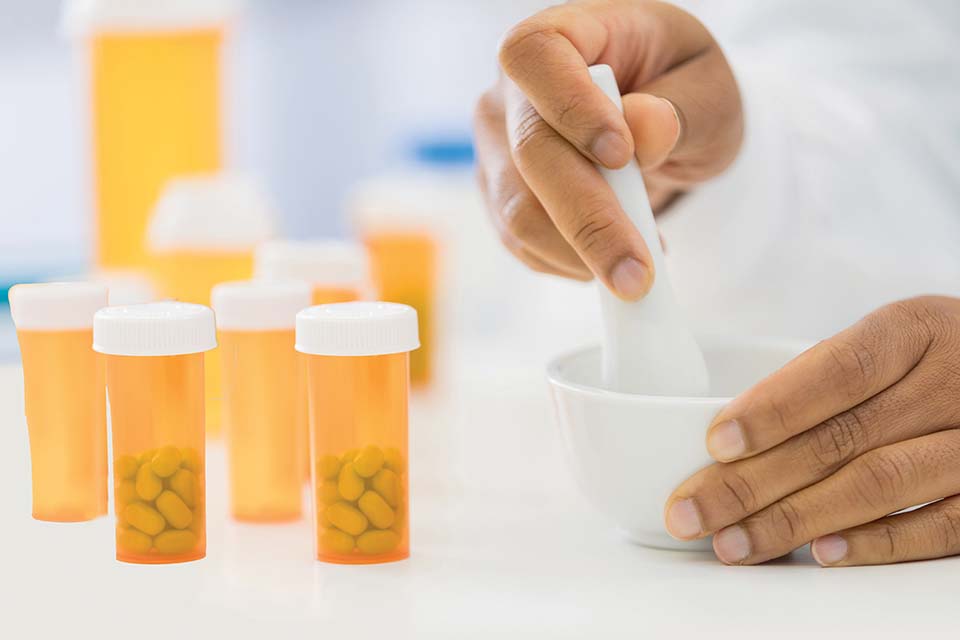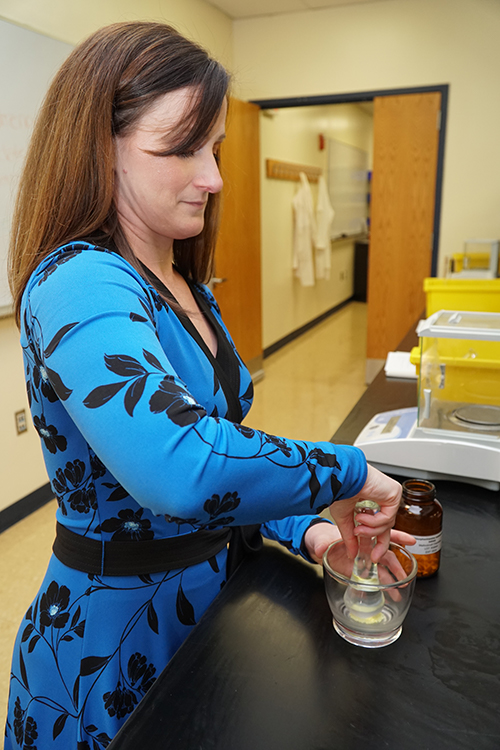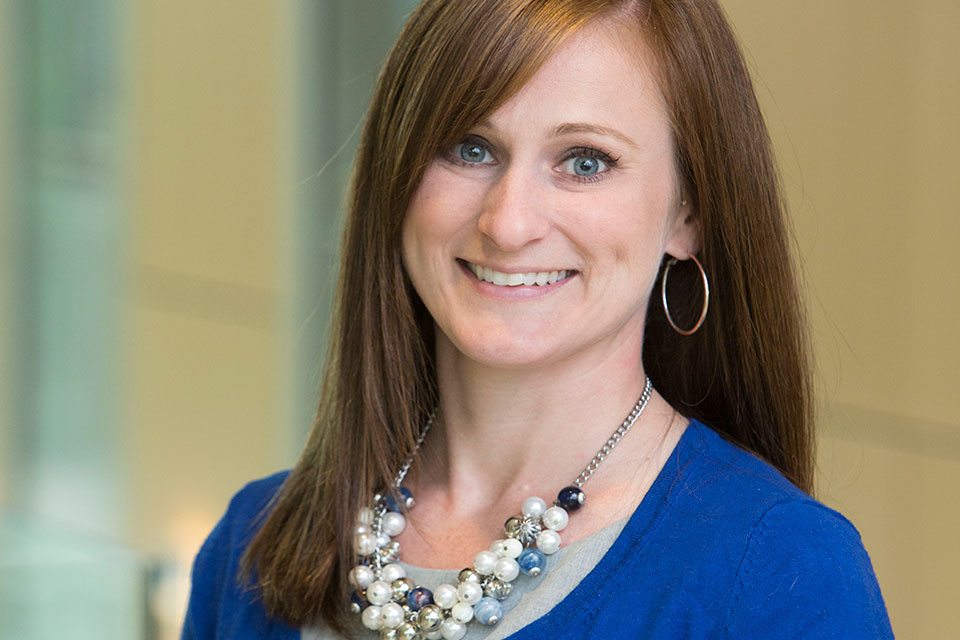FDA Grant Tasks M-CERSI with Reviewing Substances Compounded by Outsourcing Facilities
M-CERSI receives grant to study how drug ingredients are combined, mixed, or altered to create tailored medication.

By Randolph Fillmore
January 1, 2022
Under a 2018 $2.2 million U.S. Food and Drug Administration (FDA) grant, Ashlee Mattingly, PharmD, MPH, BCPS, an assistant professor in the Department of Pharmacy Practice and Science at the School of Pharmacy, and her colleagues in the University of Maryland’s Center of Excellence in Regulatory Science and Innovation (M-CERSI), have been investigating how substances compounded by outsourcing facilities have been used historically and currently.
Pharmaceutical compounding has been defined as a process by which drug ingredients are combined, mixed, or altered to create a medication tailored to the needs of an individual patient.
“Compounding is an important niche in pharmacy practice,” says Mattingly, who is principal investigator on the grant. “Many patients, particularly infants or the elderly, may not be able to swallow pills and rely instead on compounded drugs for oral medication. Or patients may be allergic to an inactive ingredient in a commercially available product, and by compounding that ingredient can be removed and patients are still able to get the benefit of the active ingredient.”
To use a recent buzz term, compounding is “personalized medicine” at its oldest, perhaps best characterized by the iconic image of the pharmaceutical mortar and pestle.
Mattingly, who came to the School of Pharmacy in 2014 after working as a clinical pharmacist at the Community Hospital South in Indianapolis, focuses on sterile and non-sterile compounding. She also is director of PharmTechX, the School’s advanced pharmacy technician training program. She says that compounding can take place either in the neighborhood pharmacy or on an industrial scale.
“Some pharmacies will compound small lots for individual patients,” she explains. “However, large-scale compounding is generally relegated to outsourcing facilities, many of whom compound large lots and ship nationwide.”
An outsourcing facility must comply with all requirements under Section 503B of the Federal Food, Drug, and Cosmetic Act, added in 2013 with the passage of the Drug Quality and Security Act enacted by Congress to strengthen FDA’s authority over outsourcing facilities in the wake of a 2012 meningitis outbreak traced back to poor conditions and negligence at a large outsourcing facility.
Pictured: Ashlee Mattingly
“Under Section 503A, pharmacists may compound products for specific patients,” explains Mattingly. “Section 503B, however, creates a new category of compounders known as ‘outsourcing facilities’ that are able to compound on a larger scale. Outsourcing facilities don’t have to be state-licensed pharmacies, but their compounding must be done under the supervision of a licensed pharmacist.”
The law defines an outsourcing facility as a facility at one location that is engaged in compounding sterile drugs and elects to be registered with FDA. Outsourcing facilities are only allowed to compound using active pharmaceutical ingredients (APIs) appearing on FDA’s list identifying bulk drug substances for which there is a clinical need that is being developed by FDA.
Mattingly adds that outsourcing facilities must follow Good Manufacturing Practices — regulations imposed on manufacturers by FDA under the authority granted the agency by the 1938 Federal Food, Drug, and Cosmetic Act.
Outsourcing facilities also are inspected by FDA according to a risk-based schedule and must meet certain conditions, such as reporting adverse events and providing FDA with information about the products they compound.
Through the grant, Mattingly and her colleagues reviewed literature on the substances nominated for inclusion on the 503B Bulks List, a list of substances that can be used by 503B outsourcing facilities for compounding. They searched the literature for studies and clinical practice guidelines describing the use of the APIs for the medical conditions that they were nominated to treat.
They also conducted outreach to clinicians to better understand how compounded products are used and whether the nominated substances are used to compound drugs that health care providers maintain in their offices in advance of identifying the patients who will receive them.
Many drugs they have reviewed were nominated for dermatological use. Mattingly offers several examples of substances the team reviewed, and that FDA included on the final list. These include DPCP (diphenylcyclopropenone), SADBE (squaric acid dibutylester), glycolic acid, and TCA (trichloroacetic acid). Both SADBE and DPCP appear to be equally effective acetone-based solutions for treating alopecia; glycolic acid finds applications in skin care products, most often as a chemical peel; and TCA is used in cosmetic treatments, such as chemical peels and tattoo removal.
Much of the hands-on work of digging up the necessary literature to better understand the historical and current use of the bulk substances, as well as initiating outreach to clinicians who use the substances in their practices, has been the task of Laura Pavlech, DVM, MSLS, a research librarian in the Health Sciences and Human Services Library at the University of Maryland, Baltimore. Pavlech is an expert at information searching and came to the project at the beginning of the grant’s second year. She has worked closely with a team of students and postdoctoral fellows at the School of Pharmacy to carry out the reviews.
According to Pavlech, one of the most rewarding aspects of the project has been offering the students and postdocs the opportunity to work with peer-reviewed literature and the unique investigative work with databases to find the appropriate studies for review — opportunities that they might not otherwise have.
“The databases we routinely used to find journal articles for each drug are Ovid MEDLINE and Embase,” explains Pavlech. “I also searched a repository for clinical practice guidelines called ECRI Guidelines Trust.”
The team members do not make recommendations to FDA about the nominated substances, says Pavlech, but merely report their findings as it is FDA’s decision whether new substances will be recommended for inclusion on its list. She admits that when FDA adds one of the team’s nominated and well-researched bulk substances to its approved list, they have the sense of a job well done.





